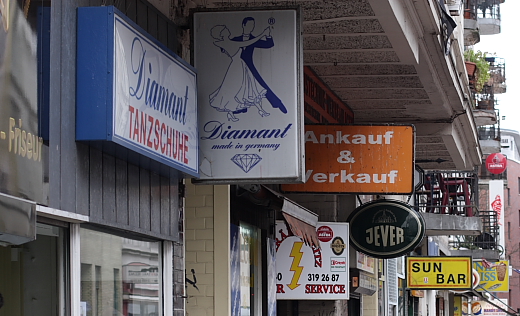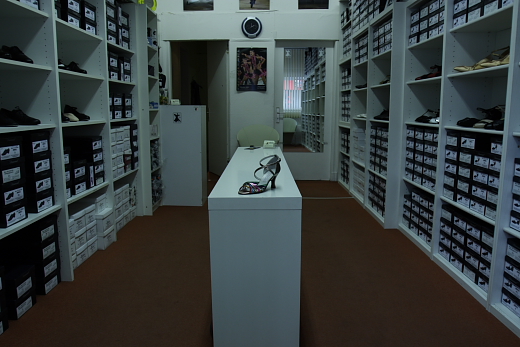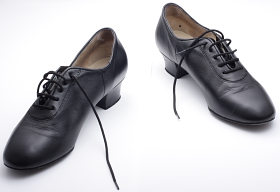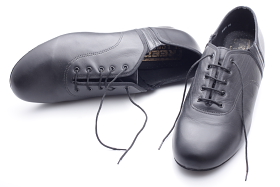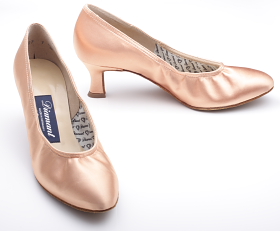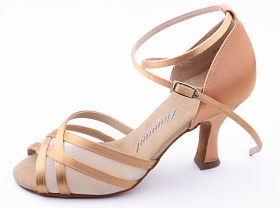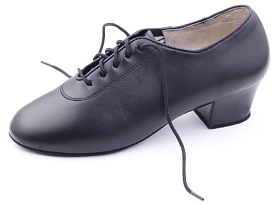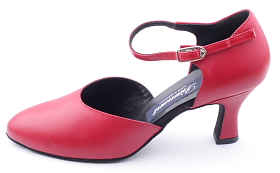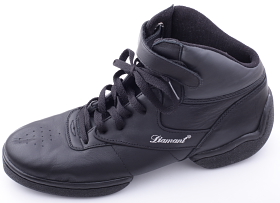1
The True Grip: How To Keep The Feet On The Ground.
Text: Kerstin Lange Photography: Helmut Römhild
The correct balance of grip and slip can be fine tuned by applying wax.
Chrome tanning doesn’t make the sole water resistent. Letting the sole absorb a certain amount of water makes it slippery agin.
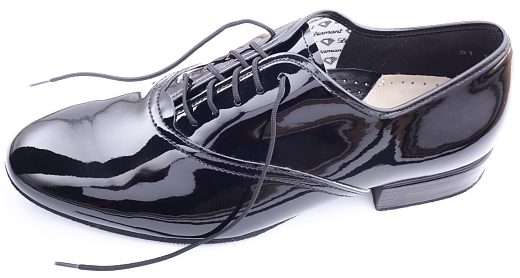
A dancer’s shoe hugs the foot almost like a sock.
The material is flexible enough to follow every twist and turn of the dancer’s foot.
Normally vamp and lining are made of leather but synthetic material becomes more and more common.
Modern materials are the basis for extremly ventilated constructions (‘Mesh’).
Ladies shoes made of satin are the preferred choice of dancers:
They match the ballgown’s colour and are dyed if the colour cannot be provided by the manufacturer.
Dancing means to control movement. This is done with the feet, in other words, with the shoe.
How to stop and stay and how to move depends on a tiny patch of leather, in the case of the ladies barely larger than a postcard.
The sole is extremely flexible, traditionally made of suede, while synthetic material is used for special constructions like sneakers.
The leather sole is also extremely thin which makes it impossible to stich the soles to the vamp. They are glued instead using heat and pressure.
The suede leather sole provides grip. Exposed to extreme compression during dancing the sole becomes more and more slippery.
To restore the rough surface and the grip a special wire brush is applied.
The ladies’ shoes are often decorated with pailletts and Svarovsky cristals
Higher level Ballroom dancers perform in ball gown and White Tie.
The gentleman’s tailcoat is always accompanied by patent leather shoes.
The normal kind of shoe is too heavy and not flexible enough to follow the dancer’s footwork.
A normal leather sole is far too slippery and even the flat sole of the gentlemen’s shoe can lead to accidents.
A rubber sole has far too much grip and makes it difficult if not impossible to turn and pivot. Forcing the turns usually injures the knees.
Tanzschuhhaus, Talstraße 17, St.Pauli, Hamburg.
Hamburg, St. Pauli: How To Buy Dancing Shoes on Reeperbahn.
The train runs underground, the station: A tunnel, tiled walls,
neon light instead of daylight. An anouncement: “Exit on the left.” Ok.
There is action on the platform, officers of the Hamburg riot police in blue combat uniform, showing muscle,
detering whatever trouble they are expecting.
“Talstrasse? Take the exit over there.” The young Lady is nice and pretty,
she wears body armour, a riot-stick is handy in her bootleg.
Up the stairs and right into the broad daylight, into the heart of St. Pauli, onto Reeperbahn.
Slot machines, a grill, I turn the corner, pass the St. Pauli Hotel, the Freedom Bar, the Salvation Army, a shop with tech gadgets –
stop, that’s too far, here, the glassdoor, a shop bell: customers!
And there I am, at the ‘Tanzschuhaus’, Talstrasse 17, at St. Pauli, Hamburg,
the former shoemaker’s workshop of W.O.Julius, after that Koopmann’s dancing shoe shop, the base of the Diamant factory in Hamburg,
since 2005 owned by Ingo Dick.
Several thousend pairs of shoes are waiting to be sold, every available size of each type.
The brands of Zeller, Diamant, Kern: Shoeboxes cover the walls like a wallpaper, continuing into the back of the shop and into the storage area.
Two young ladies are looking for something to wear on a ball, they are a little excited, two Cinderellas,
about to meet their princes – if only the shoes are right.
And here is everything what a lady needs to make an impression on the dancing floor:
High Heels, providing the feeling as if they have at least five inches, Ballroom pumps, made of silk, glowing like mother-of-pearl, Tangoshoes, dark as the night.
The service is professional, matter-of-fact, straightforward and the two young ladies learn the facts:
A beginner on four inch heels? Forget it. This is beyond your control, no fun, a lot of pain and the risk to go from the dancing floor directly to the hospital.
Performance is first, good looks second, this is the only way to enjoy the evening. Understood?
The shoes for gentlemen over there, a bit on the plain side which was to be expected,
only the Tango gives a chance to match the ladies’ outfit: Red, the classic, or two-toned.
And there is the modern stuff: Sneakers with a split sole.
Fashion? Yes, there are changes, but nothing dramatic. Sure, the stiletto heel is gone, now we have the flamenco heel,
in endless variants.
By the way: Ladies prefer the satin pumps for contests, dyed in the colour of the ball gown.
Dyeing shoes is one of Ingo Dick’s services, no problem, and don’t forget to bring a sample of the ball gowns fabric.
No, dancing shoes are not a commodity, despite the fact that a competition dancer’s training can destroy five to six pairs of shoes per year.
That’s the reason why there is only little sponsoring from shoe manufacturers in dancesport, why selling dancing shoes is a tough business.
Ingo Dick would like to expand his shop, take over the premises next door. But this would be quite an investment, refurbishing alone would cost a lot of money.
Well, we’ll see.
Tanzschuhhaus, Talstraße 17, St.Pauli, Hamburg.
When I leave the shop I’m not going empty-handed. The reason why I carry a shopping bag with two shoe boxes is probably that
here at the ‘Tanzschuhhaus’ they know their business: Professional, matter-of-fact, straightforward.
I’m certain that I will have a lot of fun with the new shoes I bought, a pair of trainers and a pair of Latin shoes, moderate heels, of course.
And I already had a lot of fun, just buying them, here, at Ingo Dick’s, just around the corner from Reeperbahn, at Talstraße 17.
It is dark outside and St. Pauli now is illuminated, Reeperbahn now a neon jungle, a much nicer place than if exposed to plain daylight.
Downstairs again, back into the underworld of the city’s transportation system. They riot police is gone: No trouble today on Reeperbahn.
Training: Workout For The Feet.
A dancer wants control to meet new challenges.
Training shoes are constructed to support the feet, to help them work.
Broad flat heels provide stability. Closed shoes, covering most of the foot, ease the strain.
Perforated material provides a maximum of ventilation and keeps the feet dry.
Also the gentleman’s training shoe covers most of the foot.
Multi-purpose shoes are available which can be used for Ballroom and Latin training as well, the highly flexible soles supporting
the typical foot work of the Latin dancer.
Ballroom Dancing: Speed, Elegance And The Feet Working Long Hours.
Relatively small heels result in less stability. A hight of two to three inches adds to the problem: Ballroom dancing is quite a challenge for the feet.
The rigid part of the sole between heel and front is relatively long, resulting in reduced flexibility.
The gentleman’s shoes are similarly constructed, the heels about one ich high, the type of shoe similar to normal
menswear.
The colour is black.
The patent leather shoe dominates the contests. Polished to perfection it accompanies the gentleman’s tailcoat.
Rumba, ChaCha, Samba, Pasodoble: Feet Under Attack.
... looking as smashing and being as difficult to control. Heels, sometimes with a hight close to four inches, turn Latin dancing into an athletic exercise.
Only highly skilled dancers can deliver top performance in these shoes, forcing them to go through the steps on the balls of the feet.
Also the gentlemen’s shoes come with higher heels of almost two inches. Like the ladies’ heels they are designed to support the typical hip movement of the Latin dancers.
The soles of Latin shoes are extremely flexible because the rigid part between hell and front is short, a design necessary for the typical foot work required in the Latin dances.
Tango: Always something special ...
A Tango shoe is at least closed at the front and is similar to the ladies’ Ballroom shoe. The heel is relatively low.
Also the black shoe is widely used by the Tango dancers, often covering the foot completely, almost like a trainer.
The gentleman’s shoe also comes in red, even multi-coloured designs are available, but normally the Tango is performed in the same
shoes as the Waltz, Quick Step, and Slow Fox.
Jogging Shoe Goes Dancing: HipHop, BreakDance und Co.
A shoe for hanging about, for playing a quick match of basketball.
At a second glance the sneaker reveals it’s real character: A dancing shoe for specialists, widely accepted as footwear for the dancing floor.
Ultralight fabric for efficient ventilation, extremely flexible, the massive soles made of synthetic material, constructed to
allow to pivot and turn without problem.
The special feature is the split sole, the gap between heel and front allows to flex the foot if necessary.
![]()
©: Ballroom Website, 2009
Updated: 02.02.2009

